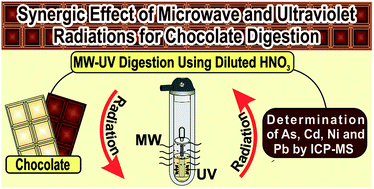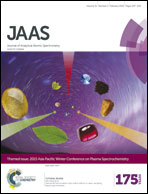The synergic effect of microwave and ultraviolet radiation for chocolate digestion and further determination of As, Cd, Ni and Pb by ICP-MS
Abstract
The synergic effect between microwave and ultraviolet radiation was proposed for chocolate digestion and further toxic element determination by inductively coupled plasma mass spectrometry (ICP-MS). As, Cd, Ni and Pb were chosen to show the applicability of the proposed method. Ultraviolet radiation was generated in situ using a low-pressure Cd discharge microwave lamp inside each digestion vessel. HNO3 solutions of several concentrations (2, 4, 7 and 14.4 mol L−1) were evaluated as digestion media. Parameters such as sample mass and microwave irradiation time were also evaluated in order to provide the best conditions for chocolate digestion. A relatively high sample mass, up to 600 mg of chocolate (white and milk), was digested using a diluted acid solution (10 mL of 4 mol L−1 HNO3), allowing for a final solution with dissolved carbon content lower than 100 mg L−1, which was suitable for ICP-MS measurements. The accuracy of the proposed method was evaluated by the digestion of a certified reference material (CRM, BCR 414), and the agreement with the certified values for all analytes was between 95 and 98%. Recovery tests were also performed and results between 95 and 104% for all analytes were obtained. The limits of detection for As, Cd, Ni and Pb by the proposed method were 0.87, 0.98, 29.7 and 7.85 ng g−1, respectively. Thus, for the first time, chocolate was efficiently digested using only a diluted acid solution (digestion efficiency was higher than 90%). Moreover, the digests were suitable for subsequent ICP-MS analysis without any filtration and/or extra-dilution step, as generally reported in the literature.


 Please wait while we load your content...
Please wait while we load your content...